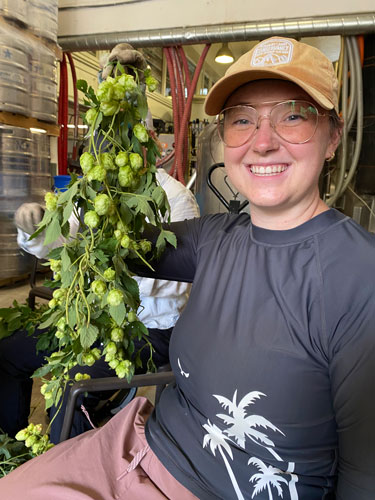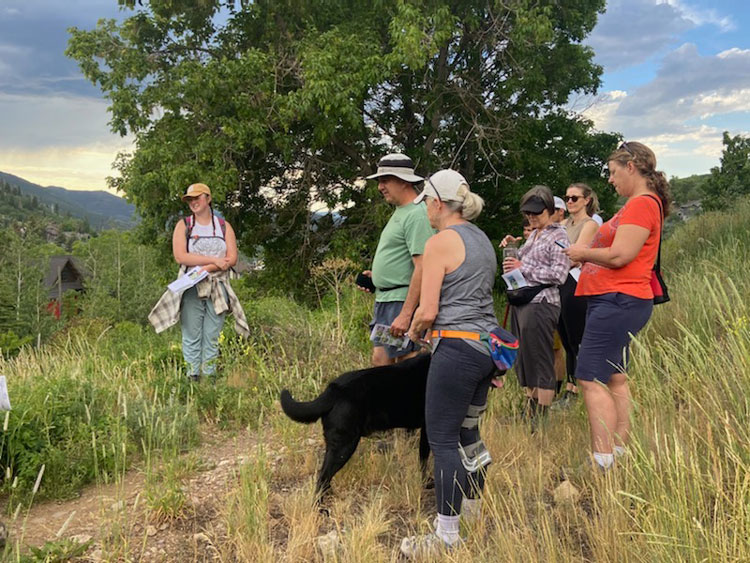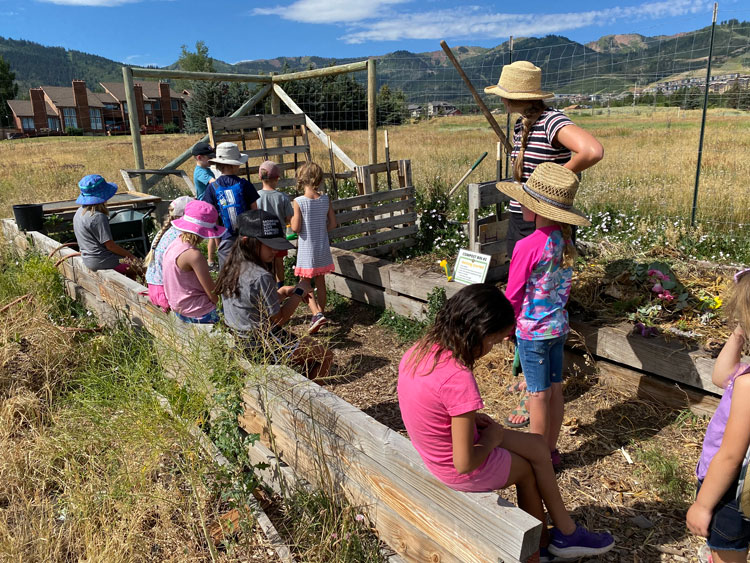Community Engagement Spotlight: Tessa Scheuer

Tessa Scheuer's love and awe for the natural world began in a small farm town at the base of the Uinta Mountains. Growing up, Tessa spent her free time playing in the grass and trees, hiking around the Uinta-Wasatch-Cache National Forest, and boating at Jordanelle Reservoir. In 2020, Tessa graduated magna cum laude from the University of Utah with an honors degree in Communication and minors in Linguistics and Spanish. Since graduation, Tessa has worked in the field of environmental education with organizations such as Summit Land Conservancy and Conserve Utah Valley to help spread awareness and appreciation for the natural world.
Tessa’s research in the Environmental Humanities focuses on environmental education as a method of fostering resiliency and connection in the face of climate change. Tessa’s thesis work combines accessible, digital education and experiential learning methods to encourage emotional resiliency and place-based sensory connection as a way to understand and confront eco-anxiety and climate grief.
Below are Tessa's written responses to questions asked in February, 2023.
Last year you were the Education Programs Coordinator for Summit Land Conservancy. What did your role entail?
In my role as the Education Programs Coordinator, I had the opportunity to work with a large variety of people. During the winter and spring months, I helped design and teach lessons to the elementary students of Park City School District for their Afterschool Program and their Friday Enrichment Program. These lessons helped get the students outdoors to learn about things such as land conservation, natural cycles, and open space while encouraging critical thinking skills and a deeper connection to the natural world. During the summer months, I helped lead Summit Land Conservancy’s Outdoor Explorers Summer Camps. These camps connected children ages 7-12 to Park City’s protected land through outdoor recreation such as mountain biking, hiking, sailing, and gardening. Using experience from past years, I helped develop outdoor activities surrounding themes such as land and water conservation, sustainability, and environmental care.
I also had the opportunity to lead Summit Land Conservancy’s long-running Hops Hunters Program for adults. Throughout the summer, I led a series of wildflower hikes on Park City’s public lands to monitor Park City’s populations of naturally growing hops. At the end of the summer, we collaborated with Wasatch Brew Pub to harvest these natural hops to make a naturally sourced beer to help raise money for Summit Land Conservancy and their efforts to save land. The Hops Hunters Program also allowed me to become familiar with the local flora of the Wasatch Back, and I was able to create a 20-page plant identification guide of the local plants of Park City.

What drew you to work in environmental education? What are the challenges and joys of this kind of work?
My love for environmental education began at Jordanelle State Park. In 2019, I received an internship working as the lead ranger’s aide for the Aquatic Invasive Species (AIS) Team. During this internship, I discovered that teaching people about how to protect Utah’s water sources brought me an unmatched sense of joy and purpose. Although spending hours upon hours in the hot sun talking to people about quagga mussels is not what many would consider fun, I thrived in my role as an environmental educator. My greatest joy is teaching people about the environment and seeing them become just as excited as I am about a plant, landscape, or environmental project. When I educate people about the environment, I feel as though I am learning just as often as I am teaching, and the relationships I have developed with both those I teach and with the environment continue to inspire me every day.
Unfortunately, many who work in the field of environmental education are chronically underpaid. Finding consistent work in environmental education that pays a livable wage can be extremely difficult. Many jobs in environmental education, especially those in snowy climates such as Utah, are seasonal, which means that they only pay for a few months at a time, pay lower wages, and offer fewer benefits. As a result, the employment field for full-time environmental education work is often very competitive and inaccessible. Further, many jobs in the environmental field are listed as internships or volunteer work, so they offer no pay at all. The inability to find substantial work in the field of environmental education was part of the reason I began my work with the Environmental Humanities Program. It is my substantial hope that the future field of environmental education becomes more accessible.

How did your upbringing in the Wasatch Back and Uinta Mountains motivate or impact your work with Summit Land Conservancy?
Growing up in Kamas Valley gave me a unique perspective on the environment. My childhood home stands at the base of the Uinta Mountains, so my sister and I used to spend hours exploring the pastures, woods, and waters in the surrounding areas. This time spent playing outdoors built the foundations on which my wonder and joy for the environment lives. Now, as I dedicate my research to helping residents of Salt Lake City feel connected to the environment, I feel like I have a special perspective on all the local flora and fauna that the Wasatch Back has to offer. When the opportunity to work with Summit Land Conservancy arose, I was thrilled because it meant that I would be able to more deeply explore my relationship with the beautiful landscape that brought me so much joy as I was growing up. For me, connection to place is a crucial part of the resiliency process, especially in the face of environmental issues, so my familiarity with the land helped me form a more genuine relationship with the people of Park City and to better navigate the emotional complexities of environmental work.
Your research and thesis in the Environmental Humanities Program examines ways to increase public engagement in local environmental issues. Can you share more about this project? What strategies for increasing engagement are you exploring?
For my thesis project, which is called Project Eco SLC, I am building a website of environmental lessons to help residents of Salt Lake Valley learn more about climate change. The idea for Project Eco SLC developed because I noticed a gap in accessible environmental education for adults. When I tell people that I am studying environmental humanities, the first thing many people tell me is that they would love to learn more about the environment but don’t know where to begin. With this inaccessibility in mind, Project Eco SLC will house seven environmental lessons that focus specifically on the ways that environmental issues affect Salt Lake Valley such as air quality, drought, and eco-anxiety.

More than anything, Project Eco SLC encourages meaningful relationships with both our local communities and the environment, and making knowledge accessible is the most important step in the relationship-building process. To help people build these relationships, I focus on building mental, physical, and emotional knowledge. Each lesson contains 5 parts: a written explanation of a local climate issue, a practical skill that helps mitigate the effects of each issue, individual actions to take that benefit Salt Lake at a community level, local organizations working on the issue, and a sensory prompt that encourages people to spend time outdoors. This combination of more traditional, scientific knowledge with experiential, practical knowledge offers a more accessible way of engaging with climate issues because it offers several different ways that people can get involved. Combining mental, physical, and emotional knowledge helps to create a well-rounded knowledge base that engages the whole body, and this embodied education technique can help people feel more confident in their ability to move with issues such as eco-anxiety, climate grief, and feelings of overwhelm that can inhibit community engagement.
The next step for Project Eco SLC is to build community partnerships. It is my hope that I will be able to continue my work with Project Eco SLC after graduation. I believe that there are opportunities to collaborate with local non-profits, community organizations, and governmental agencies to bring awareness to the project. With a little bit of community support, Project Eco SLC has the potential to take flight.
What advice do you have for other students seeking to work with a local nonprofit and/or do community engaged research?
Although it can be very rewarding to work with non-profits and do community engagement work, the non-profit world is not without its faults. Unfortunately, many non-profit organizations are entrenched in America’s system of capitalism, and that entrenchment can lead to issues with wages, overworking, and burnout. I was fortunate in my work with Summit Land Conservancy, but to work in the field of non-profits and community outreach, you have to be willing to advocate for yourself and your community. Knowing your own worth and setting healthy boundaries is crucial to building genuine and equitable relationships with both non-profit employers and the communities they serve. Spending ample time with your local communities to find out their needs, concerns, and desires is also a crucial part of community engaged research. Any time spent building deeper, more meaningful relationships within your community is time well-spent.
Categories
Featured Posts
Tag Cloud
- community engagement (12)
- outdoor recreation (2)
- outreach (1)
- alumni (3)
- admissions (1)
- faculty (8)
- practitioner-in-residence (2)
- cultural anthropology (1)
- utah award in the environmental humanities (1)
- environmental justice (2)
- STEMCAP (2)
- STEM (2)
- water (1)
- communications (2)
- humanities (1)
- Taft-Nicholson Center (1)
- director (3)
- student (5)
- API (1)
- Asian American (1)
- Pacific Islander (1)
- graduation (1)
- research (3)
- thesis (1)
- project (1)
- Indigenous (1)
- Shoshone (1)
- Great Salt Lake (2)
- Bear River (1)
- land acknowledgement (1)
- STEMAP (1)
- public engagement (1)
- science (1)
- science communication (1)
- Wilkes Center (1)
- climate change (1)
- climate science (1)
- climate policy (1)
- policymaking (1)
- funding (1)
- storytelling (1)
- radio (1)
- journalism (1)
- racial justice (1)
- outdoor education (1)
- writing (1)
- non-fiction (1)
- energy extraction (1)
- reading (1)
- environmental education (1)
- affect theory (1)
- media (1)
- rhetoric (1)
